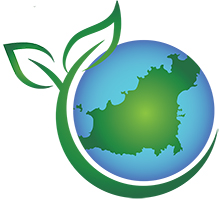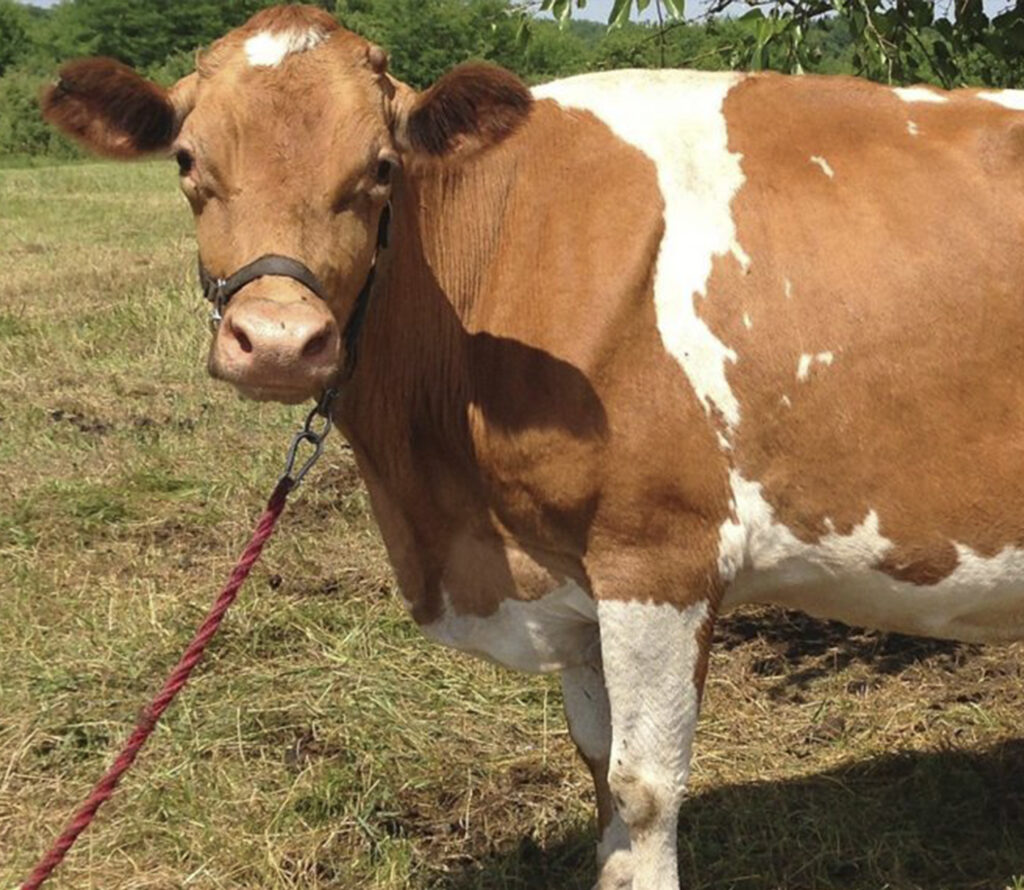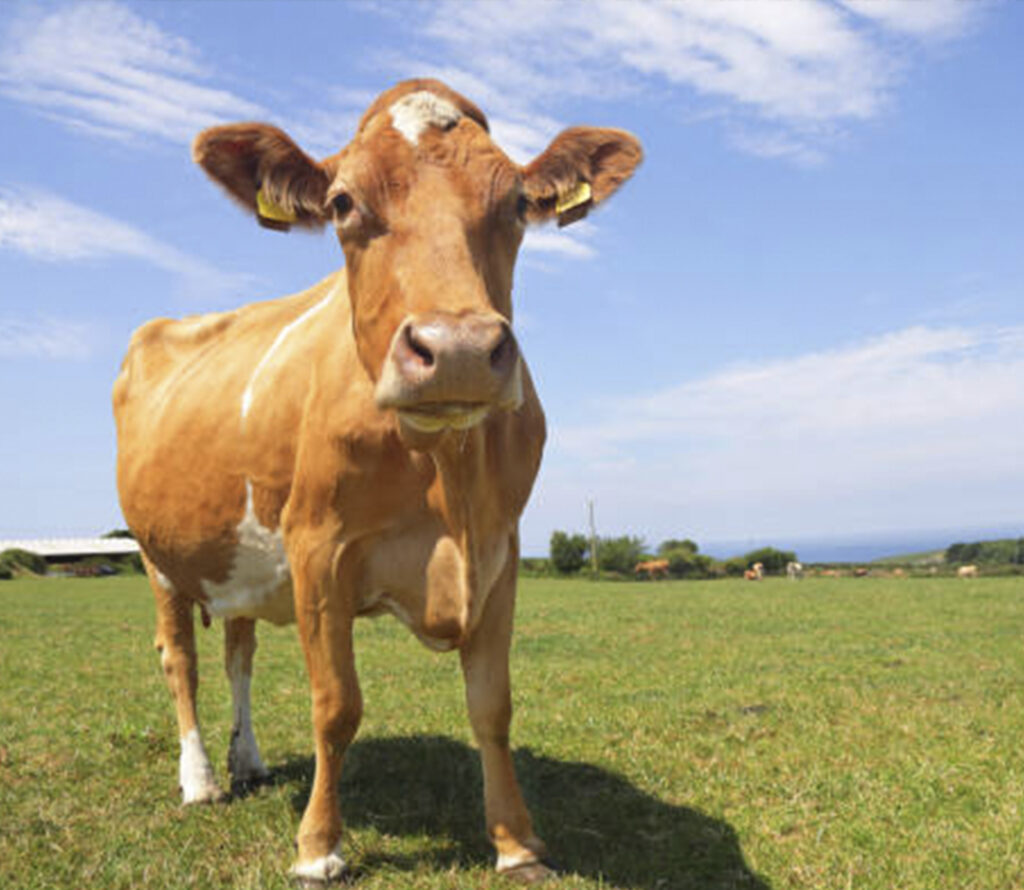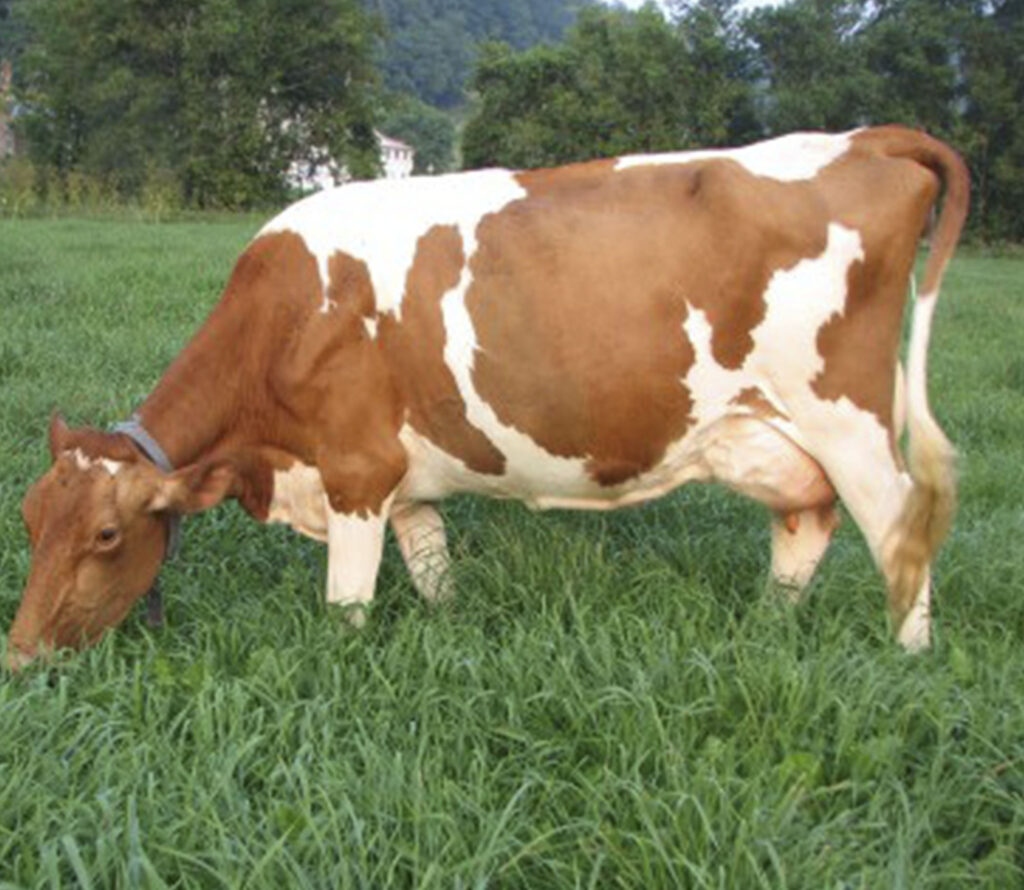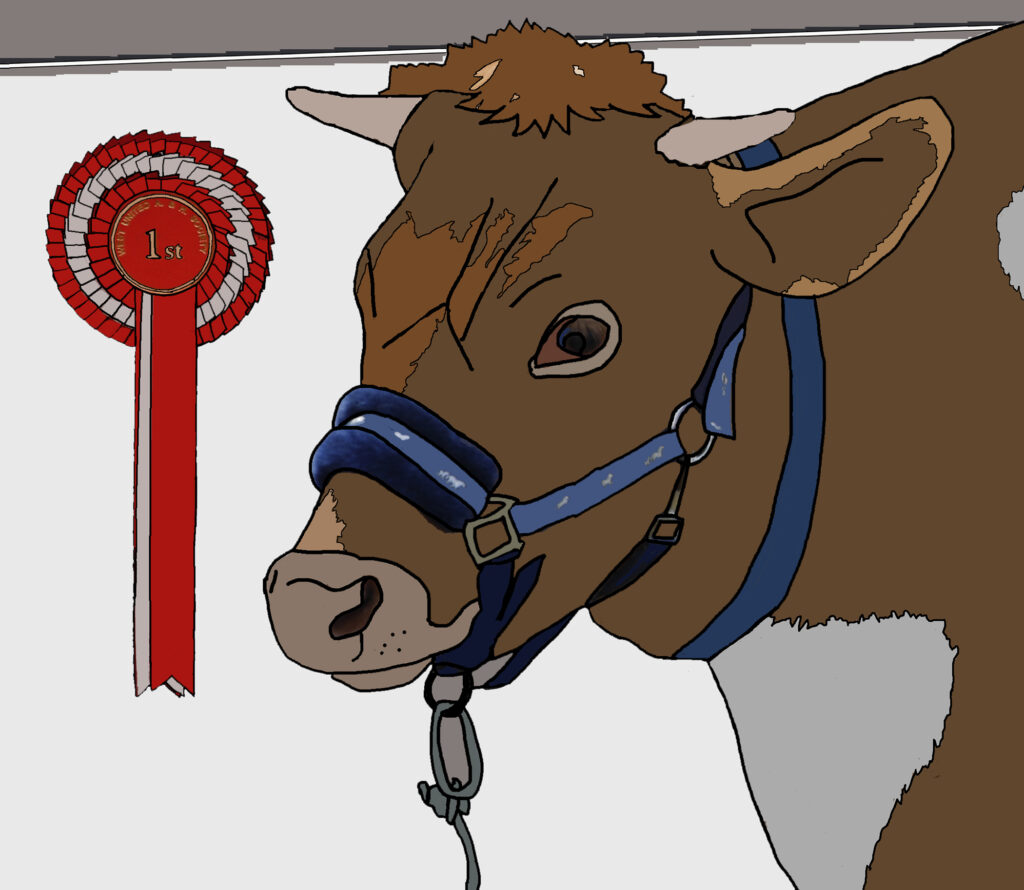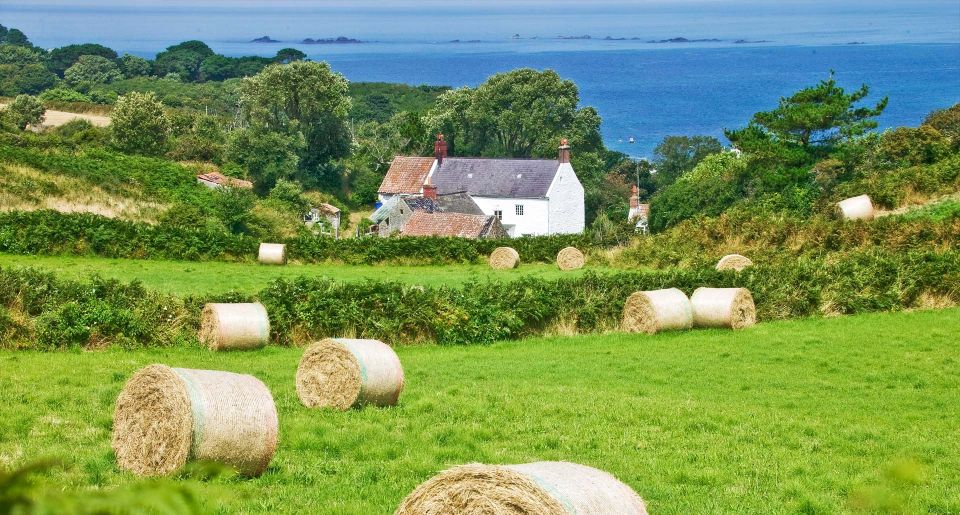Dairy farmers use about 8000 vergees of land. Commercial potato growers and market gardeners (vegetable growers) use another *1500 vergees. The remainder is used by horse owners, and by others for a wide range of leisure uses.
(*unable to find a 2022 update)
The 8000 vergees of land used by dairy farmers is divided into just over 4000 fields. The average size of a Guernsey field is less than 4 vergees, or about 1.4 acres. No-one knows the average size of fields in England but most must be over 10 acres even in the livestock rearing western counties, and many in the cereal growing counties will be well over 100 acres. This gives an idea of how small in scale agriculture in Guernsey has remained.
The small size of fields may originally be traced back to a Celtic field pattern. They are therefore some of the oldest historical features that we see in Guernsey. Later, new fields were created in their present size as they were reclaimed from scrub or woodland that existed before. Some fields have been sub-divided due to the old Norman system of inheritance division of property between the sons – that remained in the island up to fairly recent time (1948).
The fields are fragmented both spatially and geographically. Farmland is divided into many small fields by the traditional hedge banks and the land used by farmers is very divided. This geographical fragmentation causes immense problems in the management of farms and results in many more road journeys than on an equivalent English farm.
Because of the small field sizes and the fragmentation of land, farming in Guernsey tends to be small scale and does not benefit from the economies of scale. Consequently machinery and labour costs are very high. Labour costs are also very high compared to the mainland due to the affluent state of the rest of the island economy.
Land tenure is a great problem. Most farms in England are either owned by the farmer or rented as a whole on a long term tenancy. Even now as farms have become amalgamated a farmer may only have 2 or 3 landlords. In Guernsey only 20% of the farm land is owned by the farmers using it. Some 80% is rented from many different owners on an ‘annual’ tenancy. Therefore farmers here have very little security. Very few have written tenancy agreements, and most of these would be for only one year. Farmers may gain or lose up to 10% of their land each year.
Dairy farming is the main farm enterprise in Guernsey. There are about 1600 cows in the island and about 1200 other cattle mainly young heifers (female animals 0-2 years of age). There were about 400 farmers keeping 2000 cows in 1950 about 5 cows per farm, and there were over 30 farms keeping about 2000 cows until the year 2000. Now there are 12 farms with 1250 cows supplying the diary with milk. This reduction in cow numbers has reduced total milk production so that the island no longer exports dairy products, and the reduction has also meant that the quantity of manures produced is less, and so farming is less intense and there is less potential for water pollution.
Each cow produces milk for a 10 month period (known as a lactation) after calving. She then has about a 2 month period when she is not milking to build up her body reserves before giving birth to another calf and starting to milk again. The amount of milk that cows produce has increased dramatically over the years with improved breeding (genetics), feeding and management. In 1950 a Guernsey cow would have produced about 3000 litres of milk in a lactation (a year). Now some individual cows produce as much as 12,000 litres per lactation, and on average they produce about 6,000 litres per lactation.
The dairy herds in the island produce about 8 million litres of milk per year. The local consumption of fresh milk is about 6.5 million litres and about 1.5 million litres of milk is made into butter and cheese for local consumption. A small amount of butter is exported. About 10 million litres were produced annually until 2001, when a Countryside Management Scheme was adopted that included a milk quota. Milk production has been reduced to the amount needed for local consumption. Before that about 2 million litres of milk were made into cheese for export to England.
Few people now drink ‘full cream’ milk about 5% butter fat. Most milk sold is now reduced fat – low fat (1.4% fat) or skimmed milk (less than 0.2% fat). This means that most of the cream has been removed by separation. The separated cream is used to make ice cream and butter for local consumption. One farm now makes high quality ice cream and yoghurt for local for sale in shops and ‘farmers’ markets’.
Cows are mainly fed on grass and imported cereal ‘concentrated’ feeds (a mixture of cereal, protein feeds, vitamins and minerals). During the summer the grass will be grazed by the cattle in fields, and the cows will be fed ‘supplementary’ concentrated feeds when they are milked twice a day. In mid-summer there is often a drought in Guernsey so sufficient fresh grass may not be available. The cows will then graze what grass is available and receive a ‘buffer’ feed of baled silage either in mangers in the fields or in a ‘feed yard’ at the farm buildings. During the winter time cows go into their winter quarters and eat a mixture of silage and concentrates.
‘Concentrates’ or ‘concentrated feeds’ are expensive because they are bulky and have to be imported high transport costs to the island add to the cost of farming here. The concentrates are a mixture of many different feeds to achieve a defined quantity of protein and energy. The miller that makes and ‘compounds’ the feeds will use a computer programme to calculate a ‘least cost ration’ and then mix all the various feeds available to provide this. The ‘raw material’ feeds include a vast range such as wheat, barley and other cereals, and by-products such as cotton seed meal (from USA and China), Soya Bean meal (from Europe, USA or South America) or canola meal etc.
Each cow will eat about 15 tonnes of grass during the summer and about 10 12 tonnes of silage during the winter. In Guernsey the silage may be made from grass, from maize harvested for forage, and from whole cereal crops sometimes mixed with legume crops such as peas. About 2 tonnes per year of ‘concentrates’ are fed to each cow to ‘supplement’ her diet this is equivalent to about 0.3kgs per litre of milk produced.
Dairy cows can live to over 10 years of age but most will be slaughtered earlier due to an infection, such as mastitis; foot problems, such as a bacterial infection; infertility (they must breed each year if they are to produce milk); or just because they are not very efficient at producing milk. On average cows start producing milk for the first time at about two and a quarter years of age and then milk for 3 ‘lactations’ before being slaughtered.
Due to BSE disease the bodies of all cull cows are now incinerated but previously (before 1996) they were eaten as beef, particularly in meat pies and beef burgers. The island has had no cases of BSE in recent years, and a sample from the brains of culled cows is tested before incineration, these have all proved negative.
Every dairy herd needs to have a number of young female (heifer) cattle being reared to come into the dairy herd. A herd of 100 cows will need to rear about 25 replacement heifers each year, so as they are 2 2.5 years of age when they first come into the herd, a herd of 100 cows will normally have between 50 65 young heifers being reared as replacement members of the herd.
There are about 70 cattle reared specifically for beef each year. One farmer has a successful farm butchery that sells local beef and rose veal from calves reared in straw pens under high welfare standards. There is a growing market for high quality home grown products.
However one local farmer is disappointed in the locals lack of interest in buying local beef and feels that the superior quality of the product needs to be promoted to the locals.
There are about 100 sheep in the island kept by 4 or 5 people, mainly as a hobby. In general, Guernsey beef, sheep and pig farming are not really profitable, this is because all the food has to be imported into the island and the small scale of operation cannot compete with external large scale producers.
Cereal farming would not be profitable in such small areas but some dairy farmers grow cereals as a ‘break crop’ because by growing cereals they produce grain that can be fed to the cows and, more importantly, they produce cereal straw that can be used as bedding for the cows. Both grain and cereal straw would have to be imported if it was not grown locally. However, in the main cereal farming could not be profitable here as a ‘stand-alone’ farming enterprise.
If cereal growing was expanded in the island then more combine harvesters would need to be purchased. These are very expensive large machines that are usually used in large arable (cereal) fields. The normal ones could not travel along the narrow Guernsey roads or go through the narrow gateways into the small sized fields. There is just one combine harvester in the island and that was built in England for use on trial plots on an experimental farm!
Potato growing has increased in recent years. These are mainly ‘maincrop’ potatoes grown to substitute for more expensive imported potatoes. A higher price is obtained than on the mainland because imported potatoes incur a cost of transport. This is quite high compared to the value of the crop because potatoes are heavy and bulky. Therefore, it is economic to grow a small area of maincrop potatoes for home use in the island. It would not be economically viable to export maincrop potatoes. Jersey produces very early potatoes of a particular branded ‘Jersey Royal’ variety. This is only economic because they obtain a higher price in England due to heavy (and expensive) promotional marketing and due to the fact that they reach the market a week or two before English grown varieties. However this market is under attack from cheaper imports of early potatoes grown in North Africa and Mediterranean countries.
Other vegetable crops cauliflower, lettuce, carrots, onions, etc., are grown in the island in small-scale market garden operations for direct sale to the public. Currently the price is dictated by the cost of importing vegetables grown in Jersey or on the mainland. These farming operations are only profitable when they supply the local market – which is of a limited size. The enterprises could not expand because they would then compete with each other and reduce the price of fresh vegetables. The enterprises could not be expanded for an export trade because there is a substantial transport cost to the mainland and they would then be competing with vegetables grown in much larger field scale operations at a lower unit cost.
In general, farming in Guernsey is expensive because it is insular from mainland UK and European markets. Consequently, all the feeds, fertilisers, building materials, equipment and supplies have to be imported. The size of farms, fragmentation of land, size of fields, lack of security of tenure and labour costs all make farming in the island much more expensive than in England or in Europe. Therefore without special help farming here could not compete.
The maintenance of farming in Guernsey is very important because it maintains a traditional environment, preserves wildlife habitats and manages the open land areas of the island. This open land is very important because it provides the open ‘green lungs’ of the island and the environment in which we all live.
There are a number of ‘agri-environmental issues and problems. The main problems within the island are:
(a) nitrate pollution and dirty water run off to streams;
(b) pesticide pollution of water supplies;
(c) loss of landscape character and wildlife habitats.
A Guernsey Countryside Management Scheme was introduced in 2001 to reduce pollution and conserve wildlife. This scheme makes payments to dairy farmers for compliance with a wide range of wildlife, animal welfare and environmental (water pollution) protection measures. Grants have been provided so that all farms must now have winter storage for organic manures cow dung and urine for at least a 4 month period. There is a ‘closed period’ between 1st October 31st December each year, during which time nitrogen containing fertilisers and organic manures, including slurry, must not be applied to the land.
